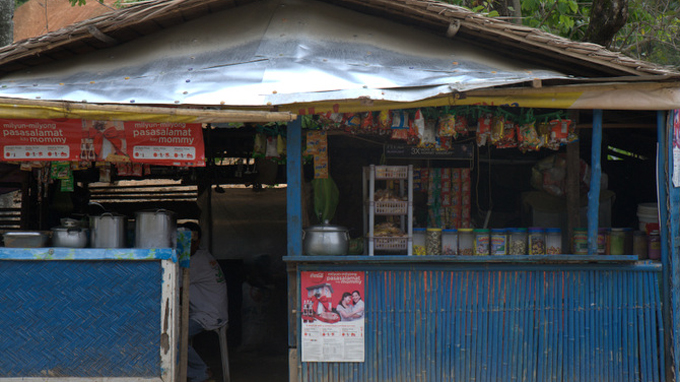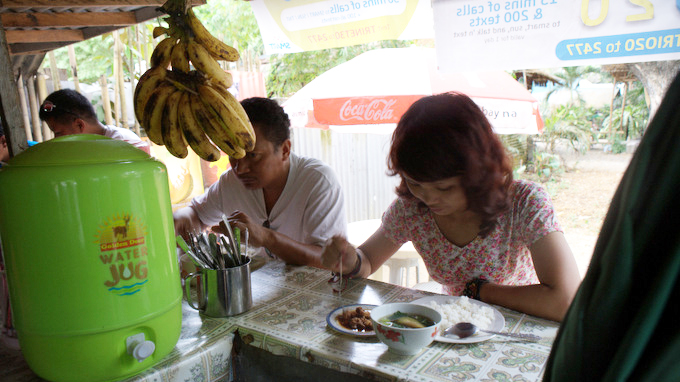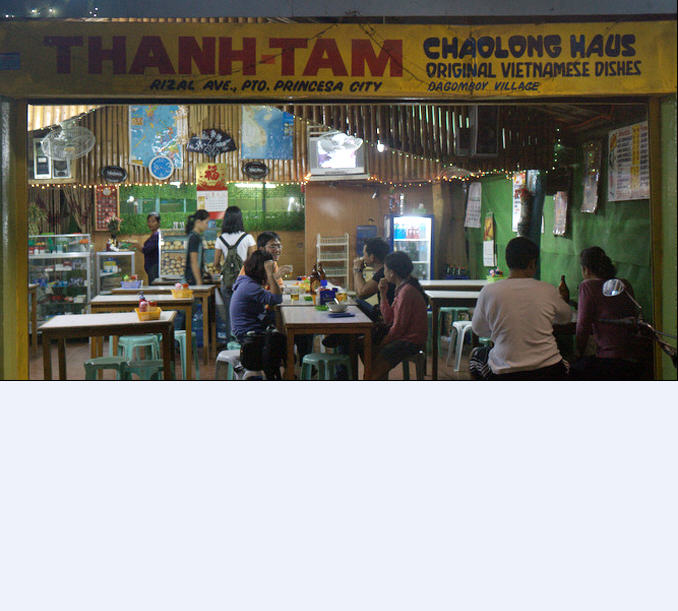Even though I'm not a big eater, whenever I go to a new place, I always look for the opportunity to enjoy food the way the locals do.
It is always an enjoyable and valuable experience for a trip.

A "Vietnamese porridge" shop in Puerto Princesa - Photo: Giang Nguyen
We landed at Puerto Princesa airport, Palawan island (Philippines) at 10am and were instructed to walk outside the airport to find a bus to El Nido.
Not far from the airport, right on the main road with lots of trees, there is a travel agency located between several small houses.
While my companion went in to ask about renting a car and some information for the trip, I took my camera and strolled around the streets. Tricycle drivers (a type of motorbike with 3 wheels and a large cargo bed to carry passengers) parked along the road winked at us and invited us to take a tour of the capital.
Since we had to wait for the truck to load before leaving for En Nido, everyone declined. It was already lunchtime so we had to go find a place to eat.
Filipino street food
Next to the travel agency is a small grocery store. At first glance, it resembles the miscellaneous stalls in the Vietnamese countryside, with goods hanging from the walls or windows.
On the horizontal table were several trays and a series of clean covered pots, with empty space outside and a row of benches under the porch.
There was also a table and chairs in the other corner, with bananas hanging from the table. I was curious and opened some pots to see, and saw all sorts of dishes: mixed vegetables, stir-fried vegetables, rice, soup, meat, and fish.
The two female owners were busy clearing plates and serving food to the customers. The restaurant wasn’t crowded, but busy enough. A few tuk tuk drivers stopped by to eat. Some old men who probably lived nearby stopped by to eat. There were even Western tourists passing by who stopped by. And our group decided to have our lunch here.
Later, when I had more time to travel to the Philippines, I realized this is a typical cheap rice shop in this country.

A Western tourist stops in front of a street food restaurant in Puerto Princessa - Photo: Giang Nguyen

Street food stall and grocery store - Photo: Giang Nguyen
The shop displays pots and pans and food trays on a long table by the window. Customers come to buy and sit outside to eat. There are also separate tables and chairs inside to serve.
Each shop also doubles as a small grocery store selling candy, fast food, drinks, cigarettes, and cosmetics to serve locals and passersby.
Each person in the group chose a few dishes including white rice, soup, vegetables and side dishes. In terms of appearance, the dishes looked quite similar to Vietnamese street food.
Vegetable soup, shallot and tomato salad, braised meat, fried fish or sauce. But the cooking and seasoning is Filipino style.
For example, braised pork is slow-cooked with vinegar, soy sauce, garlic, onion, pepper, and salt. Mixed soup has tofu, tomatoes, onions, and diced green beans, cooked with tamarind or lemon. Many dishes are cooked in sauces, so it is easy to see why there are so many pots on the table instead of trays.
Vietnam and "pork porridge"
We ate and chatted with the other diners in the restaurant. When they found out we were Vietnamese, a few people in the restaurant said “chao long” which surprised everyone.
It was not until the night before we left Palawan that we understood why people here say “chao long” when referring to Vietnam.
It turns out that Palawan is a place where many Vietnamese people have come to do business and settle down for a long time, even forming Vietnamese villages. Along both sides of the road near the airport, there are many restaurants with clear Vietnamese names for the dish “cháo long”. Thinking that they would be enjoying their favorite dish in a foreign land, the whole group was “shocked” when every restaurant owner showed them a menu with the word “noodle” (noodles, pho).
Had to go to a few shops and look around to find out that the dish "chao long" that the people of Palawan island call is actually Vietnamese pho.
Chicken pho, beef pho, pork pho, even driverless pho. It seems that in the distant past, when Vietnamese people came here to live and run food businesses, there was enough confusion that in Palawan, the locals always called their favorite pho “cháo long”.

A simple meal - Photo: Giang Nguyen
What a surprising and memorable story in our journey to explore Palawan!

 VI
VI EN
EN

































